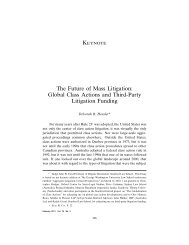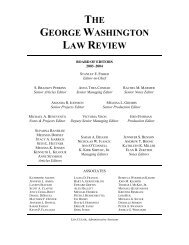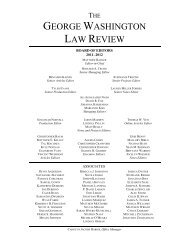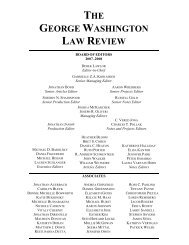View PDF - The George Washington Law Review
View PDF - The George Washington Law Review
View PDF - The George Washington Law Review
You also want an ePaper? Increase the reach of your titles
YUMPU automatically turns print PDFs into web optimized ePapers that Google loves.
2010] Derailing Penn Central 885<br />
III.<br />
An Exploration of Post-Lingle Takings Jurisprudence<br />
With the potential death of Penn Central’s character prong and<br />
the Supreme Court’s previous wavering between per se rules and balancing<br />
tests, one can only hypothesize how the Court will approach<br />
future claims of regulatory takings. This Part begins by assessing the<br />
Court’s most likely approach, which is the continued and unaltered<br />
application of the Penn Central balancing test as though Lingle never<br />
occurred. After concluding that this approach is deficient, this Note<br />
examines an alternative approach. <strong>The</strong> merits of this second approach,<br />
which is an abandonment of Penn Central and a resort to the<br />
per se rules of Lucas and Loretto, are also examined, and this Note<br />
ultimately concludes that this approach is also inadequate.<br />
A. Option Number One: Stubbornness<br />
If history is any indication of which approach the Court will take,<br />
it will likely continue to apply Penn Central’s ad hoc balancing test.<br />
<strong>The</strong> Court has been reluctant to abandon Penn Central, despite past<br />
indications that this approach would be superseded. As mentioned<br />
previously, the per se tests of Lucas and Loretto were once believed<br />
by some to represent an effort to replace Penn Central as the sole<br />
methods of analysis. 89 Nevertheless, the Court returned to its “polestar”<br />
in subsequent regulatory takings inquiries. 90<br />
<strong>The</strong>refore, it would come as little surprise if the Court continued<br />
to apply the Penn Central balancing test as though Lingle had not undermined<br />
it, just as it continued to apply Penn Central following Lucas<br />
and Loretto. 91 Advocates of this approach argue that Lingle left the<br />
character prong unscathed. 92 <strong>The</strong>se advocates interpret Lingle narrowly<br />
and view the Court as holding only that a regulation’s failure<br />
under a substantive due process analysis does not require the government<br />
to give just compensation. 93<br />
89 See supra notes 34–40 and accompanying text.<br />
90 See Tahoe-Sierra Pres. Council, Inc. v. Tahoe Reg’l Planning Agency, 535 U.S. 302, 336<br />
(2002).<br />
91 Another less likely option is that the Court will apply an altered version of the Penn<br />
Central balancing test. This would mean that the Court would acknowledge that Lingle foreclosed<br />
application of the character prong, but would nonetheless apply a simpler version of the<br />
Penn Central balancing test that focuses solely on economic impact and distinct investmentbacked<br />
expectations. See Whitman, supra note 70, at 590 (arguing that the elimination of the<br />
character element of the Penn Central test “simplifies and rationalizes Penn Central in a desirable<br />
way”).<br />
92 See, e.g., Romero, supra note 82, at 365.<br />
93 See id. at 360 (advocating for the position that “[t]he Court’s rejection of the substantial









